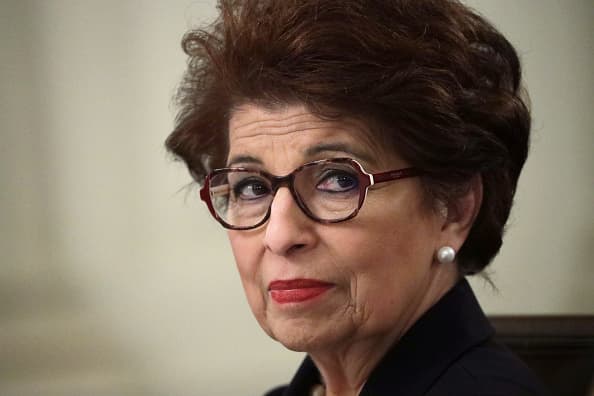Jovita Carranza, head of the Small Business Administration, listens during a roundtable discussion with governors and small-business owners.
Alex Wong/Getty Images
Millions of small businesses have gotten federal aid to help weather the recession caused by the coronavirus pandemic.
Despite that relief, many don’t expect to survive the crisis.
Entrepreneurs who close their doors may be wondering if they’ll be on the hook if their business received a Paycheck Protection Program loan or Economic Injury Disaster Loan.
“I think this will become one of the biggest issues [for loan recipients],” said Nick Oberheiden, a Dallas-based attorney. “I received the loan, I’m going out of business, now what happens to my loan liability?”
Nearly a quarter of small businesses have considered closing their doors permanently because of Covid-19, and 12% are facing potential bankruptcy, according to a survey published last week by Small Business for America’s Future.
More from Personal Finance:
14% of businesses expect layoffs after using PPP funds
Is there a need for another stimulus check?
Trump says he’s open to more stimulus checks
Here’s a silver lining: PPP loans and disaster loans smaller than $25,000 have relatively favorable terms for borrowers, according to experts. And, in the event of bankruptcy, the loans can generally be discharged, they said.
But there are important caveats, especially for larger loans made through the EIDL program.
The Paycheck Protection Program, created by the CARES Act legislation enacted in March, offers forgivable loans to small businesses.
The disaster loan program existed before the pandemic. The CARES Act updated it to provide emergency grants of up to $10,000 to small businesses.
The Small Business Administration, which administers the loans, has doled out nearly $630 billion in combined funding since the crisis began.
Loan defaults
All PPP and EIDL loans up to $25,000 don’t require collateral or personal guarantees from the business or business owner.
So, in the event a borrower can’t repay the loan and defaults, the lender generally wouldn’t be able to seize business or personal assets.
However, the risk of a loan default isn’t to be taken lightly, experts said.
The creditor — in this case, the federal government — may report the business to the credit scoring companies, which could adversely affect the ability to borrow again and increase their interest rate on any future debt.
The federal government, unlike a typical creditor, also has the ability to seize federally held assets such as a company’s income tax refunds or any other amounts due from the federal government, said Paul Becht, CPA, partner at Margolin, Winer & Evens.
The picture is murkier for EIDL loans that exceed $25,000, which are collateralized.
Any assets that remain in the business — such as warehouse inventory, receivables and equipment like machinery or trucks — could be seized by the SBA to cover an entrepreneur’s outstanding debt.
In addition, disaster loans exceeding $200,000 require a personal guarantee. That means the lender can also go after the business owner’s personal assets — cars, bank accounts, investments and personal tax refunds, for example — to secure outstanding debt.
“That is a much scarier proposition,” Becht said of an EIDL loan’s personal guarantee.
Bankruptcy
Businesses that want to avoid a loan default can instead seek bankruptcy protection, according to Oberheiden.
He advocates filing for Chapter 11 bankruptcy under the Small Business Reorganization Act, which allows “small businesses a really fast and unbureaucratic reorganization while they’re in bankruptcy protection.”
PPP and EIDL loans can generally be discharged in bankruptcy, said Michael Brauneis, managing director and leader of the North American financial services group at Protiviti, a consulting firm.
Whose mistake was it? What should banks have done? What should borrowers have done?
Michael Brauneis
managing director at Protiviti
However, complications may arise, especially with PPP loans, that could impact a borrower’s ability to get the loans discharged, Brauneis said.
The SBA and Treasury Department created application guidelines and forms speedily in their haste to get federal relief funds out the door to ailing businesses, which led to different application review policies and approaches among banks.
The ‘big debate’
One risk for borrowers going through bankruptcy is that if the SBA or bank investigates and find errors on the part of applicants in the initial application process, that could potentially put the ability to have a loan discharged at risk, Brauneis said.
“As some of these loans start to turn sour, that will be the big debate or dispute in the litigation,” Brauneis said. “Whose mistake was it? What should banks have done? What should borrowers have done?”
There’s a similar but lesser concern relative to EIDL loans, since those loans are originated by the SBA and banks don’t serve as middlemen as with PPP loans, he added.
However, EIDL loans exceeding $200,000 come with an additional risk due to the personal guarantee, since the business owner (in addition to the business) may need to seek bankruptcy protection to have the debt discharged, experts said.
The question of what happens to the debt could ultimately be a moot for PPP borrowers. That’s because the federal government may forgive the loan’s entirety anyway if used according to program guidelines around factors such as payroll costs and overall loan duration.
However, the issue isn’t quite clear, and may depend on things such as when a bankruptcy proceeding is initiated and when a business applies for loan forgiveness, experts said.
